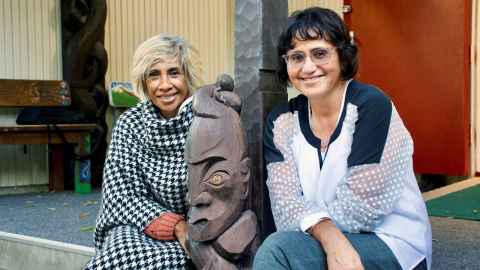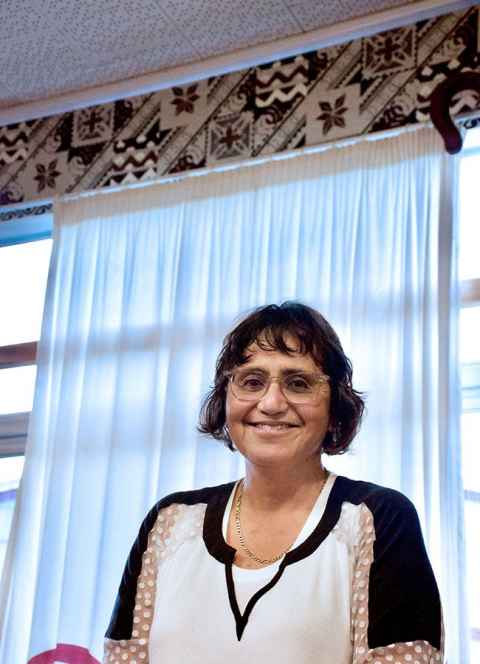Lively Pacific presence at Epsom Campus Marae
6 November 2023
Pacific taonga inside the wharenui at Epsom Campus Marae symbolise the enduring ties between tangata whenua and peoples of Te Moana nui-a-Kiwa, write Rose Yukich and Hēmi Dale.

On the eve of the 40th anniversary of the wharenui, the stories behind its Pacific taonga are being recorded for the Marae History Project, sponsored by the Faculty of Education and Social Work.
The Epsom Campus marae begins the process of moving to the City Campus after the anniversary celebrations on Saturday 18 November.
Among those sharing memories for the project are three former teacher trainees, all first-generation New Zealanders of Pacific descent. Becoming a part of the marae’s creation helped them to connect with their own cultural heritage.
“During my time at what was then Auckland Teachers College, little did I realise as an observer, and as a participant in the world of te ao Māori, that it would be the birthing place of my identity both as a teacher and as a Polynesian,” says Nerina Howe (Samoan).
“Being in the Māori Studies Department and on the marae was the first time I got a real sense that my identity was worth far more than the physical aspect of it. I learned that I did not have to be ashamed of being a Polynesian. I didn't have to pretend to be a Palagi imprisoned in a brown-skinned outfit as unpopular or popular as that would have been.”
Nerina’s reflections sit within the social and historical context of the 1970s when the population of Pacific peoples rapidly increased in Tāmaki Makaurau. Schools scrambled to adjust to the expanding and vibrant cohorts of Pacific students in hitherto mostly monocultural classrooms dominated by Pākehā values.
From 1980, the developing marae at Epsom Campus became a haven for younger Pacific students enrolled in the three-year teaching diploma.
By the late 1970s, Auckland Teachers College had begun offering a one-year refresher course for experienced teachers from the Pacific, but the first lecturer in the new field of ‘Pacific Island Studies’ was not appointed until 1988.
From 1980, the developing marae at Epsom Campus became a haven for younger Pacific students enrolled in the three-year teaching diploma.
Like Nerina, Tiere Maoate gravitated to the marae, spending many hours researching and producing two of the tapa panels in the wharenui related to her Cook Island and Tahitian heritage.
“The marae was definitely a safe space for me. I was raised in Māngere and as a young person I didn’t identify with many things. Working on the tapa, I not only embraced Māori but also learnt about my own culture,” reflects Tiere.
Encouraged by the leader of the marae initiative, Tarutaru Rankin (Ngāpuhi), Tiere also communicated with relatives in Rarotonga to source a whāriki (woven mat) for the wharenui that was symbolic of welcoming.
“The mat they chose features ta’iri [fans]. I ended up talking with my family about the cultural significance of the fan. When you came up in your waka and saw the women on the shore – if they were standing there fanning themselves, it was a peaceful time for you to come. But if they weren’t there, don’t even think about landing.”

The packaged-up mat duly arrived by mail from Rarotonga. It was cut to size and still graces the wharenui, beautifully preserved, as if it had been installed yesterday.
On the opposite wall to the Cook Island mat is a Samoan tapa panel painted by Cilla Godinet with assistance from the late Gaynor Niumata. It represents a creative response to important facets of their Samoan culture and history.
Cilla created this contemporary tapa during her last year of teacher training in 1983. She took inspiration from her extensive reading, deep conversations with people and the Pacific History paper she completed at the University of Auckland.
“The imagery depicted in the repeated tapa patterns is around navigation, religion and faith, flora and fauna and the meshing of various cultures reflected in my own heritage – Samoan, French, German and English,” recalls Cilla.
“I was very aware at the time of those who settled in Samoa for all sorts of reasons and then at some point travelled on, for example, to New Zealand. There’s a sense of the impact of colonialism which I was not necessarily aware of back then.
"But it is also a story of my parents and forebears who were courageous, visionary and insightful, and whose mana continues to thrive. This tapa still manages to surprise, delight and challenge me today.”

Stories such as those shared by Nerina, Tiere and Cilla are helping shed light on the Pacific taonga inside Tūtahi Tonu.
But, whether creating art work, making cups of tea, performing waiata, banging in nails or laying down hāngi, the significant contribution of Pacific students four decades ago to the making of the Epsom Campus Marae is strongly woven into its narrative DNA.
If readers have archival material (images or documents) for the Marae History Project, please contact: Hēmi Dale on hemi.dale@auckland.ac.nz or Rose Yukich on r.yukich@auckland.ac.nz.
Media contact
Julianne Evans | Media adviser
M: 027 562 5868
E:julianne.evans@auckland.ac.nz